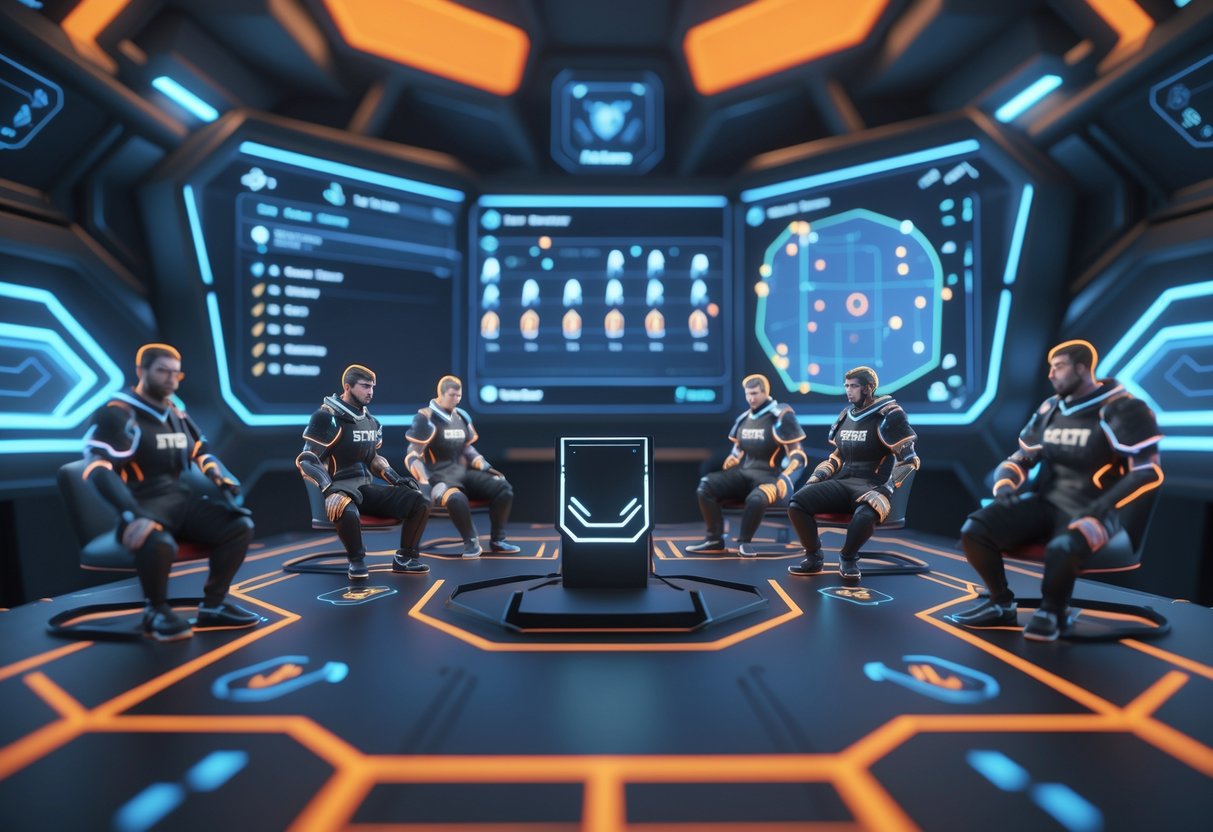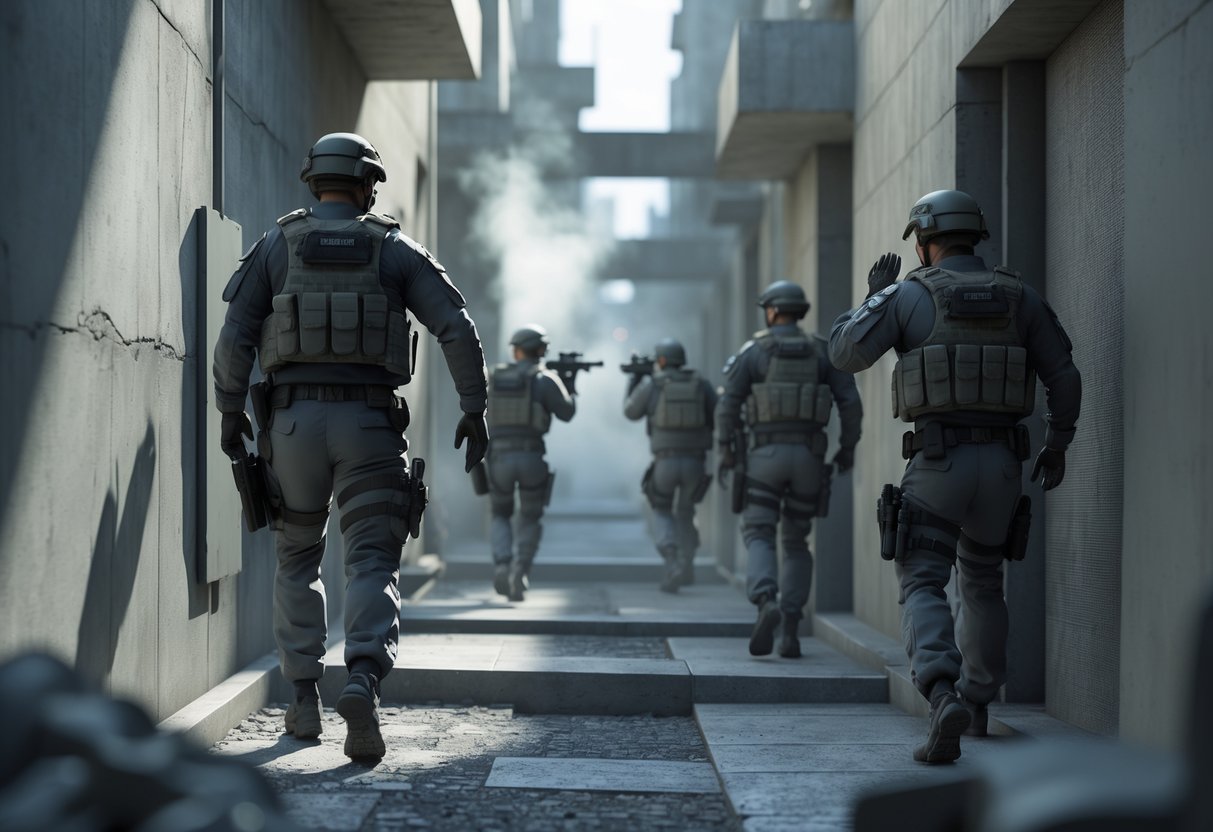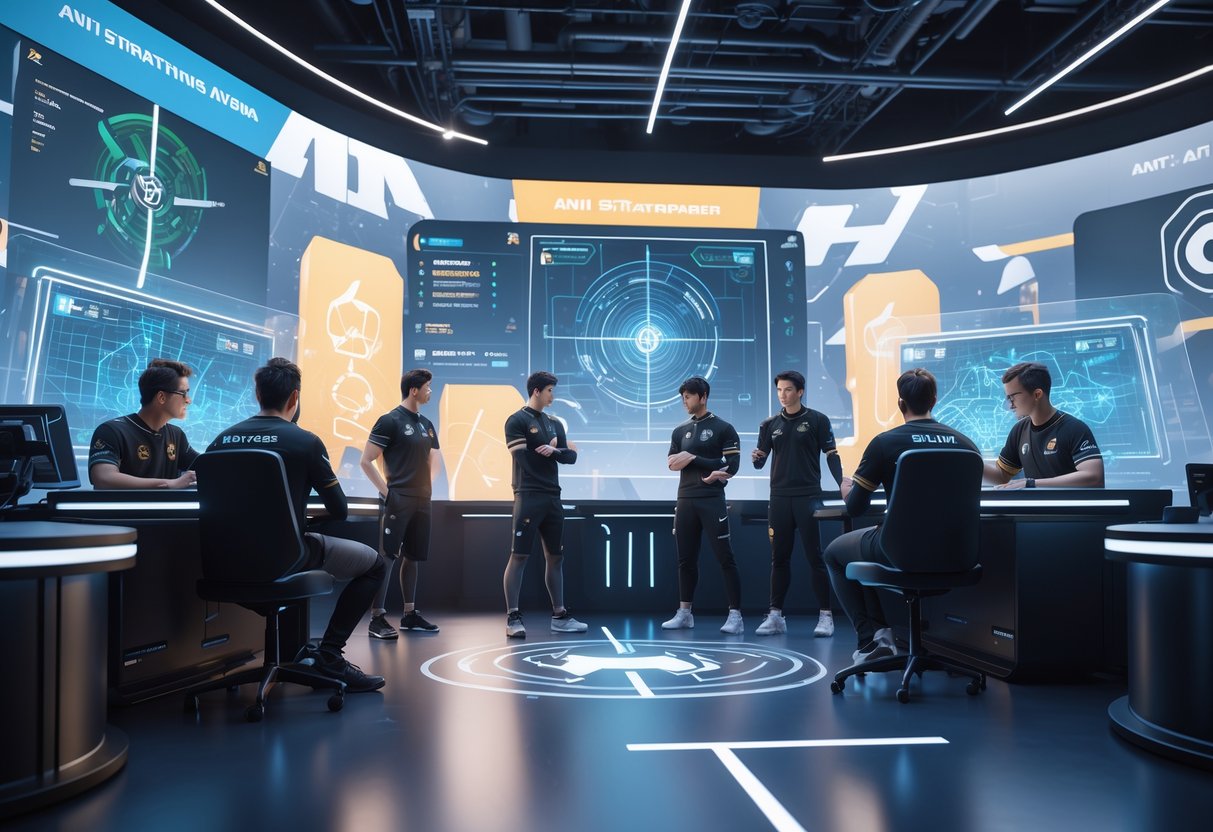Anti-Stratting: Advanced Tactics in Esports and VALORANT
Updated On: October 26, 2025 by Aaron Connolly
What Is Anti-Stratting?
Anti-stratting is all about digging into your opponent’s strategies and tactics, trying to predict and shut down their moves before they even get started. Teams use this method to grab a competitive edge by prepping responses for common plays.
Key Principles of Anti-Stratting
Think of anti-stratting like prepping for a chess match. Teams pore over match footage, hunting for how opponents play certain maps or situations.
They focus mostly on three roles: the lurker, entry fragger, and main AWPer. These roles tend to give away the most about a team’s strategies.
If you study the lurker, you can often figure out team movements. For example, when the lurker hides in Palace on Mirage, it’s a pretty good sign the team’s heading for B site.
Entry fraggers are like an early warning system. Spotting them tells you when a site attack is about to kick off.
Watching the AWPer? That tells you about defensive setups. Knock out the main sniper, and suddenly your team can move a lot more freely.
Teams rely on demo analysis and lots of note-taking. They watch older matches to spot patterns and habits.
Origins of Anti-Stratting in Esports
Counter-Strike teams started anti-stratting way back in the early days. Someone realized that if you studied your opponent, you’d have a real shot at outplaying them.
By 2012-2014, pro CS teams had made it standard practice. Analysts came onboard to break down match footage in detail.
You can actually thank traditional sports for the idea. Football teams have always watched tapes to prep for games.
Esports just took it further—digital demos let you rewind and scrutinize every move. The practice quickly spread to games like Valorant and Rainbow Six Siege.
Any tactical game with set strategies can benefit from anti-stratting. It’s just the nature of the beast.
Importance in Competitive Play
Anti-stratting often tips the scales in pro matches. Teams that counter their opponents’ plans usually snag the crucial rounds.
Having an information advantage is massive in tactical shooters. If you know where the enemy likes to go, you can stop guessing and set up your defense.
Some people complain it kills skill expression. But honestly, good anti-stratting takes a crazy amount of game sense and fast thinking.
Pro teams spend hours reviewing demos before big games. Coaches and analysts work together to spot weaknesses.
This kind of prep forces everyone to step up their game. If you don’t mix up your strategies, you’ll get picked apart.
Modern tournaments move fast, so teams don’t always have much time to anti-strat. That’s when having a deep playbook really pays off.
How Anti-Stratting Works in Team Games
Teams create anti-strat plans by studying opponents’ habits and building counters for their go-to plays. It starts with a deep dive into enemy tendencies, then moves to tactical prep that targets their predictable moves.
Analysing Opponents’ Playstyles
We kick off anti-stratting by watching demo footage of whoever we’re about to play. This helps us spot who fills which roles and how they usually act in certain scenarios.
Key roles to watch:
- IGL (In-Game Leader) – Runs team strategy and rotations.
- Lurker – Operates away from the main group.
- Entry fragger – Charges in first to attack bomb sites.
- Main AWPer – Holds key angles as the team’s main sniper.
Lurkers tend to give away the most. Teams often stick them in obvious places, like Palace on Mirage. If we see the lurker early, we can usually guess where the attack’s headed.
| Role | Information Value | Prediction Accuracy |
|---|---|---|
| Lurker | Very High | 80-90% |
| Entry Fragger | High | 70-80% |
| AWPer | Medium | 60-70% |
We care about patterns, not just one-off rounds. Most teams below the pro level keep using the same lurker spots and attack paths. If you do your homework, you can really punish that.
Counter-Strategy Development
After we spot their patterns, we start building counters for their favorite moves. We’re not trying to counter everything—just their bread and butter.
Three main counter moves:
- Information gathering – Listen for footsteps or utility in the usual places.
- Aggressive positioning – Push areas we expect them to show up.
- Direct confrontation – Take aim duels with their key players.
For lurkers, we usually put someone on lurk-watch. That way, no one sneaks up on us, and we get a heads-up on where the main push is coming.
Against entry fraggers, we set up crossfires in their favorite peek spots. If we drop the entry fragger early, their whole plan tends to fall apart.
Pro tip: Don’t try to counter every little thing. Focus on their biggest strengths and set up to stop those.
Predicting Opponent Routines
Teams fall into habits with their economy, utility, and timing. We track these to try and stay one step ahead.
Stuff we watch for:
- Force-buys right after losing pistol rounds.
- Specific utility tosses on certain maps.
- Default setups that basically announce what’s coming.
- How quickly they rotate between sites.
The IGL uses all this info to move us around for the best chance at a hold. If their lurker’s in Palace and their entry fragger drops mid, we can guess they’re limping into B site.
Heads up: Some teams will fake out anti-strats by throwing in new plays or switching it up mid-match.
Anti-stratting works best against teams that don’t adapt well. Pro teams might ditch their usual plans if they think we’ve studied them. Lower-level teams usually struggle to change on the fly, so anti-stratting really shines in amateur play.
We have to balance anti-stratting with working on our own game. If we focus too much on countering others, we risk becoming predictable ourselves.
Anti-Stratting in VALORANT
VALORANT throws a wrench into anti-stratting with all its agent abilities and wild tactical options. The IGL shoulders most of the responsibility for studying enemies and adjusting on the fly, but analysts definitely pull their weight with VOD reviews and data crunching.
Role of the IGL in VALORANT
The IGL in VALORANT juggles more than in most shooters. They’ve got to track agent picks and predict when certain abilities will show up.
During games, IGLs look for little hints that give away what the other team wants to do. If Sova always darts the same angle on Bind, we can prep for it and maybe even shut it down. Quick rotations get way more important when anti-strats land.
A lot of pro IGLs spend three or four hours a day just watching opponent demos. They’re looking for agent combos and timing tells. Maybe a team always hits A-site after Omen drops a smoke on connector—if so, the IGL flags that.
The best IGLs can change things up mid-game if their anti-strats flop. Sometimes that means moving players around or calling a totally different execute.
It’s a lot to handle. IGLs have to call strats, scan the minimap, and frag out—all at once. No wonder so many teams bring in analysts to help out.
VALORANT Analyst Insights
VALORANT analysts use some pretty advanced tools to break down how opponents play. They’ll build spreadsheets tracking agent picks, round wins, and where players tend to go.
Modern analysts really care about economic patterns too. They track when teams force-buy, save, or gamble on risky buys. Sometimes, reading the economy is even more useful than reading tactics.
Map control is another big one. Analysts figure out which spots teams fight for on different rounds. Some squads always battle for mid on Haven, while others just split sites right away.
Video analysis tools make this easier. Analysts tag moments when opponents stack sites, rotate early, or chain certain abilities. These tags go into a searchable database, so you can pull them up fast.
Stats show that teams with analysts do 15-20% better in anti-strat situations. The workload’s just too much for IGLs alone, especially during packed tournament schedules.
Preparation and Adaptation Strategies
Before a match, teams often spend 8-12 hours studying their opponent. Coaches, analysts, and players usually split up the work.
Most teams set up simple callouts for common enemy patterns. If they spot a certain setup, they’ll call “Alpha response” or something similar. It keeps comms snappy when things get tense.
Timing matters a lot in VALORANT adaptation. If you change up too soon, you might ditch a working strat. Wait too long, and the other team can run away with the momentum.
| Adaptation Timeline | Action Required |
|---|---|
| Rounds 1-3 | Run your anti-strats as planned |
| Rounds 4-7 | Make small tweaks |
| Rounds 8+ | Go for big changes if needed |
Backup plans are a must. Pro teams prep two or three different plans for every opponent. If the first anti-strat flops, they swap to a standard default.
Some teams even practice “anti-anti-stratting” in scrims. They’ll show fake patterns, then switch things up in real matches. It’s a bit of mind games on top of everything else.
The Analyst’s Role in Anti-Stratting
Analysts really drive anti-stratting in esports. They spend hours watching opponent footage, looking for patterns to exploit. Their job is to turn all that raw gameplay data into strategies the IGL can actually use in matches.
Data Collection and VOD Reviews
VOD analysis sits at the heart of anti-stratting. Analysts dig through dozens of matches, searching for repeated patterns in positioning, utility, and decision-making.
Most analysts focus on scrims and official matches. These games show how teams really play under pressure.
What analysts track:
- Where players set up each round
- When and how they use utility
- Personal habits and quirks
- How teams handle their economy
It’s slow work and takes a sharp eye. Prepping a single anti-strat can mean watching 10-15 matches from the same team.
Good analysts spot little things that predict what the enemy’s about to do. Maybe a team always smokes mid doors on Dust II before a catwalk rush—if so, that’s a tell you can use.
Practical Tools and Techniques
Modern analysts lean on special software to speed up the process. Demo tools let them go frame-by-frame and track patterns across games.
A lot of teams keep spreadsheets full of tendencies—everything from site execs to how fast players rotate.
Some common anti-stratting tricks:
| Technique | Purpose | Application |
|---|---|---|
| Hard counters | Predict exact plays | Put players in place to stop expected rushes |
| Tendency mapping | Spot probability patterns | Adjust setups to fit opponent habits |
| Player profiling | Exploit personal habits | Target certain players with custom strats |
Stats help analysts find the most reliable patterns. If a team runs the same strat 70% of the time in a certain situation, that’s worth prepping for.
Some analysts go deep on stats, others trust their gut and what they see. Both approaches can work, honestly.
Communication with Coaches and IGLs
Clear communication turns analytical insights into executable strategies. Analysts need to break down complex patterns into simple terms that IGLs can actually remember when the pressure’s on.
Most successful analysts work side-by-side with coaches to build anti-strat plans. Coaches help decide which insights are actually practical to use in the middle of a match.
Effective communication means:
- Boiling down hours of analysis into a few key bullet points
- Using visual aids and map drawings
- Explaining how confident you are in each prediction
IGLs count on analysts to point out the most exploitable weaknesses. Instead of dumping every pattern on the team, good analysts pick the three most reliable counters.
The best analyst-IGL partnerships keep the conversation going throughout matches. Analysts watch live gameplay and jump in with real-time adjustments as opponents adapt to early counters.
Many pro teams set aside practice time just for anti-strat setups. This way, players can make complex positioning changes quickly when the analyst spots key opponent tells.
Applying Anti-Stratting in Official Matches

Official league matches in ESEA and CEVO are perfect for anti-stratting. Teams get access to opponent demos and predictable match schedules. These leagues offer solid demo databases and enough prep time to really dig into enemy tactics.
Scouting in ESEA Leagues
ESEA leagues give us big demo libraries, making anti-stratting actually doable. We can grab recent matches and scrims from teams we’re up against.
Key things to watch for in ESEA demo reviews:
- Opening round patterns – Most teams stick to similar pistol round setups
- Economic round strategies – How they handle force-buys and save rounds
- Individual player habits – Where certain players like to sit
- Smoke and flash timings – Teams often repeat their utility
The ESEA client stores demos for weeks after matches. We should check out at least 3-5 recent matches from our opponents.
Look for trigger indicators that point to specific plays. Say terrorists smoke mid doors on Dust2—if they do, they often rush catwalk with two players.
Heads up: Demos older than two weeks aren’t reliable. Teams change things up fast in active leagues.
Anti-Stratting in CEVO
CEVO matches use similar prep strategies as ESEA, but with different demo systems. The league structure lets us predict our opponents weeks ahead.
CEVO’s round-robin format means we get to study teams multiple times per season. We can tweak our anti-strats as teams adapt.
Effective CEVO prep looks like this:
- Watching both wins and losses from opponents
- Noting how they handle economic pressure
- Spotting their default setups on each map
- Tracking individual player roles and positions
Teams in CEVO often stick to their favorite strategies longer than in other leagues. That makes them a bit more predictable for anti-stratting.
We should make simple callout sheets for our team. Jot down 2-3 key tendencies per map so we can counter them mid-match.
Using Demo Reviews for Preparation
Demo analysis is the backbone of good anti-stratting in official matches. We need systematic approaches to pull useful info from opponent footage.
Start with recent scrimmage demos. These show teams’ current strategies without the pressure of official matches.
Try a simple spreadsheet to track opponent tendencies:
| Map | Round Type | Opponent Pattern | Our Counter |
|---|---|---|---|
| Dust2 | Pistol | Mid smoke + catwalk rush | Fast boost two players |
| Mirage | Anti-eco | A site execute | Stack three A, rotate fast |
Focus on high-percentage situations where opponents repeat plays. Pistol rounds and force-buy rounds are usually the most predictable.
Quick win: Spend 30 minutes watching just pistol rounds from 3-4 recent demos. Most teams run the same setups every time.
Watch demos at 2x speed at first to spot big patterns. Slow it down when you find something worth countering.
Split up demo analysis across your team. Let different players focus on specific opponents or map areas, and you’ll save a lot of prep time.
Anti-Stratting Against T-Side Roles

To counter terrorists well, we have to know which players fill which roles and how they usually behave. The three most important roles to watch: lurkers, entry fraggers, and AWPers. Spotting these players gives us clues about enemy strategy and positioning.
Identifying the Lurker
Lurkers split off from the main group and give away enemy intentions through their position. Most teams have a dedicated lurker who repeats similar patterns.
Finding lurker positions means watching opponent demos. Look for the player who always separates from the team on certain maps. On Mirage, lots of teams leave a lurker in Palace during B-site executes.
We can gather lurker info three ways:
- Listening for audio cues – footsteps, weapon drops, bomb sounds
- Information pushes – send someone to probe near suspected lurker spots
- Direct confrontation – push the lurker position with one or two players
The safest method uses audio info. A single footstep from Palace can reveal the lurker without risking a player’s life. That helps us predict where the other four terrorists will hit.
But watch out: Directly fighting lurkers is risky, but gives the clearest info about enemy positions.
Countering Entry Fraggers
Entry fraggers lead executes and signal site pushes when spotted. Taking out the entry fragger often breaks the whole terrorist plan, since they rely on this player to open space.
Most teams have a go-to entry fragger who always goes in first. Demo reviews show who this is and which routes they like.
When we spot or kill the entry fragger, we know:
- The terrorists plan to execute soon
- The rest of the team is probably close
- We should rotate extra defenders to that site
Early entry fragger kills are huge. Without their entry, terrorists have to switch up their plan or send less experienced players in first.
The trick is to put defenders where entry fraggers usually show up. Pre-aiming those spots, based on demo analysis, can net easy picks against predictable entries.
Neutralising AWPers
Terrorist AWPers control key areas and make rotations tricky. If we eliminate the AWPer, we can take back risky angles and play more aggressively.
Lower-level teams usually keep AWPers with the main group instead of sending them off for solo picks. That makes AWPer positioning easier to predict when you know the other roles.
Priority targets:
- Long-range angles where AWPers like to hold
- Rotational paths the AWPer uses
- Execute support spots where AWPers cover teammates
Coordinated pushes work best against terrorist AWPers. Smoke them off and push from multiple angles to block their escape. Unlike CT AWPers, terrorist AWPers often don’t have backup nearby.
Quick win: Combine role info for a big edge. If we hear the lurker in Palace and pick off the entry fragger mid, we know four terrorists are stuck on B-site without mid control.
Counter-Terrorist Approaches to Anti-Stratting

Counter-terrorist teams have to keep changing up their defensive positions and utility usage. Success depends on reading the enemy early and shifting setups before terrorists can exploit predictable rotations or site takes.
Adapting Defensive Setups
We need to mix up our defensive positions every few rounds so terrorists can’t build effective anti-strats against us. Rotating positions keeps them guessing.
Start by swapping which players hold certain angles. If our AWPer normally covers mid on Mirage, move them to connector or palace now and then. That forces terrorists to rethink their utility and timing.
Stack variations matter too. Instead of the usual 2-1-2, try 3-1-1 or even 4-1 if you expect a site execute. Many teams give away their plans with early utility or player positions.
Mix up aggressive and passive holds in the same match. Maybe push for info in round three, then play deep site in round five. Terrorists really struggle to anti-strat teams that keep shifting their defensive tempo.
Quick rotation calls can flip the script when terrorists attack a site based on old reads. Fast rotations can turn their prep against them.
Example Scenarios in Dust II
Let’s talk about common anti-stratting situations we run into on Dust II. Terrorists study our long control and prep utility to counter our usual spots.
If we usually play one in pit and one at car, terrorists develop specific smokes and flashes for those positions. Counter this by sometimes putting both players at car or boosting one on boxes.
Watch for terrorists repeating the same utility. When they throw the same smokes for site takes, we can predict their plan and adjust. Many teams use identical utility when anti-stratting.
B tunnels are another example. If terrorists keep clearing the same angles with utility, change up our spots. Push one up towards lower tunnels sometimes, or stack three when expecting a hit.
Mid control needs constant tweaks. Teams will time their mid plays to counter our presence. Sometimes challenge early, sometimes play for picks, or just give up mid entirely.
Reading Utility Usage
Terrorist utility patterns reveal their anti-stratting prep. We need to watch how they use grenades to spot their reads on our setup.
Early round utility usually means prepared executes. If terrorists toss smokes or flashes before they scout, they’re probably anti-stratting our usual spots. That gives away their target site or strategy.
Keep track of utility between rounds. Teams that always use certain smoke lineups are prepping for specific defensive setups. Change positions when you see these patterns.
Pay attention to timing changes in their approach. If they suddenly speed up or slow down, they’ve probably picked up on our rotation habits.
Flash patterns matter too. Teams drill certain pop-flashes for our known angles. If you see weird flash usage from odd spots, expect a coordinated site hit right after.
Challenges and Limitations of Anti-Stratting

Anti-stratting comes with three big hurdles that can make or break your prep. Limited demo access, over-reliance, and unpredictable opponents can turn all your hard work into nothing.
Information Scarcity
We often can’t find enough good demos when prepping anti-strats. Lots of teams in lower leagues like CEVO or ESEA barely have any match history to work with.
New teams are the toughest. They might only have two or three recorded matches, so finding patterns is almost impossible. In Valorant’s ranked system, it’s even worse since replays aren’t always available.
Here’s what limits us:
- Private scrims – Teams practice stuff we’ll never see
- Recent roster changes – Old demos go out the window with new players
- Map pool rotations – Not much data on certain maps
- Regional differences – Teams from other places play differently
Quick win: Focus anti-stratting on established teams with 10+ recent demos. Skip the newer squads.
The time sink gets brutal when info is scarce. We might spend 8-10 hours watching demos, only to find the team has completely switched up their style.
Risks of Over-Reliance
Teams that lean too hard on anti-stratting can lose their ability to adapt on the fly. We’ve seen pros fall apart when their counters just don’t work.
The biggest risk? Becoming predictable. If teams know we’re anti-stratting, they can fake us out in scrims or change their approach entirely.
Common problems:
- Rigid game plans that can’t handle surprises
- Ignoring individual skill while focusing only on counters
- Tunnel vision—missing obvious tactical switches
- Confidence crashes if anti-strats fail early
Gaming expert James Connolly points out that teams can “become so focused on countering specific plays that they forget to develop their own creative strategies.”
Warning: Don’t throw out your team’s fundamentals for anti-stratting. Your core game plan has to be strong, even if the anti-strats flop.
Adapting to Unpredictable Play
Smart opponents love to mix things up, constantly tweaking their strategies to dodge anti-stratting. It turns into this endless cat-and-mouse chase—what worked yesterday might just get you wrecked today.
Dynamic teams don’t stick to one plan. They’ll swap approaches right in the middle of a series, sometimes even running totally different tactics on the same map. That kind of unpredictability can make all our prep feel pointless.
Valorant’s agent system just adds another layer of chaos. Teams might lock in weird agent comps that throw our counters out the window.
Here’s how unpredictability can really mess with anti-stratting:
- False information – Teams will show fake strats in earlier matches just to throw us off later.
- Tactical evolution – They keep inventing new ways to play.
- Individual brilliance – Someone will do something wild and solo that you just can’t plan for.
- Meta shifts – Game updates will completely change what works.
The best teams usually blend anti-stratting with solid fundamentals. We’ve got to have backup plans for when teams go off-script.
Quick win: Prep at least two different ways to deal with every enemy strat you spot.
Evolution of Anti-Stratting in Esports

Anti-stratting started out as just basic match prep, but now it’s a beast of its own—full-on analytical systems shape the way teams compete. Specialist analysts and coaching staff have totally changed how teams get ready for matches.
Changing Team Structures
These days, pro esports orgs have staff dedicated just to anti-stratting. Teams hire analysts who spend hours combing through opponent footage and hunting for patterns.
A lot of top teams now have anti-strat specialists. These analysts work right alongside coaches, breaking down enemy strategies in detail.
Analyst-driven prep has made results way more consistent. Instead of expecting players to study opponents in their spare time, teams now have full-time staff on strategic prep.
Warning: Amateur teams sometimes try to copy these pro structures without the resources. They end up wasting time on endless demo review instead of working on their own fundamentals.
Cloud9 really led the way with hard-counter approaches, putting in insane hours. Their run with Sean “SeanGares” Gares showed everyone why dedicated prep staff matter.
Rise of Specialist Roles
The Valorant analyst role is now standard across big titles. These folks use advanced software to break down how opponents play and build counter-strats.
Modern analysts don’t just watch demos—they crunch stats, too. They’ll track everything from individual habits to team rotations over tons of matches.
Some analysts get super specialized:
- Pattern recognition specialists find recurring strats.
- Statistical analysts dig into the numbers.
- Map-specific experts focus on certain maps.
Pro teams often put in 20-30 hours a week just on anti-strat prep. That’s a full-time job, not something you can pile onto players.
This specialist role has opened up new careers in esports. Lots of ex-pros move into analyst gigs, mixing game smarts with strategic know-how.
Impact on Coaching Styles
Coaching has shifted from just improving the team to prepping for specific opponents. Coaches now split their time between studying enemies and building their own squad’s skills.
Quick win: If you’re an amateur team, try dedicating one practice a week to scouting upcoming opponents instead of just grinding your own setups.
Coaches now run detailed pre-match briefings with analytical data. They’ll go over specific callouts, likely enemy strats, and ready-made counters for common plays.
Teams have changed up their schedules, too. Many pros alternate between days for skill work and days for strategy prep.
Some coaches go all-in on anti-stratting, while others focus on player growth. Splitting up these roles helps teams keep improving both individually and strategically.
Modern coaching isn’t just about knowing the game. You’ve got to be comfortable with demo analysis software, stat tools, and comms platforms to really help your team.
Ethics and Controversies Around Anti-Stratting

Anti-stratting stirs up all kinds of arguments in the esports world. Some people compare it to chess, while others think it’s just a cheap trick that takes away from real skill.
Stigma in the Community
A lot of fans say anti-stratting isn’t as impressive as pure mechanical skill. This idea comes from CS culture, where top teams are supposed to adapt in the moment, not just follow pre-planned counters.
People often criticize teams that win through heavy prep but fall apart when the enemy switches things up. The Guard and Northemption come to mind—they won with anti-strats but lost when faced with surprises.
Valorant players on ESEA and similar sites argue about whether anti-stratting is “real” skill. Critics say it’s boring to watch, since one team just follows a script instead of making creative plays.
Still, plenty of pros defend anti-stratting. They’ll tell you it takes deep game knowledge, pattern reading, and nerves under pressure. Reading an opponent and pulling off a counter is no small feat—it takes real expertise.
Balancing Fair Play and Preparation
The big ethical question: what counts as fair play? Everything inside the tournament rules is legal, but is it always in the spirit of the game?
Pro players argue that prep is what separates them from casuals. Teams spend weeks watching VODs, finding patterns, and building counters. That’s pretty much what coaches do in traditional sports too.
Some folks worry about strategic depth. Teams that rely too much on anti-stratting can get stuck if their plans don’t work. It can feel unfair when a less skilled team wins just by being better prepared.
Valorant’s long breaks between big events make this even trickier. Teams get months to anti-strat, so “honeymoon teams” sometimes shine in prep but struggle to adapt mid-tournament.
Case Studies from Pro Tournaments
FPX vs Paper Rex at Copenhagen 2022 is a textbook anti-stratting win. FPX figured out PRX’s aggressive style and cooked up counters. They shut down PRX’s rushes by predicting their moves and setting up in the right spots.
Fans weren’t thrilled, though. PRX’s wild style got neutralized, and people missed the hype of pure skill battles.
DRX’s repeated stumbles show where anti-stratting can fall short. Even with strong players, DRX got too predictable. Other teams broke down their VODs and countered their set plays, leading to rough exits.
Fnatic’s another example. They look great with time to study, but in tournaments that require quick adaptation, they struggle. Critics say this exposes their lack of flexibility.
Honestly, anti-stratting’s a double-edged sword in Valorant and CS.
Notable Figures and Teams in Anti-Stratting

A few big names and orgs have really changed how teams scout opponents and build counters. From tournament masterminds to leaders who reshaped prep, these folks show how powerful good analysis can be.
Hiko’s Tournament Strategies
Spencer “Hiko” Martin always speaks out about proper anti-stratting. He says counter-stratting proves a team’s dedication, not just their ability to show up and frag.
Hiko’s approach boils down to:
- Digging deep into demos before big tournaments.
- Tweaking team comps to match opponent habits.
- Using anti-stratting as a base, not a crutch.
Hiko thinks teams should welcome being anti-stratted—it forces them to get creative and build deeper playbooks. He’s pointed out that the most consistent teams are hardest to counter, which pushes everyone to step up.
He usually spends weeks on opponent analysis, checking agent picks, site executes, and how players act in clutch moments.
Influence of IGLs and Analysts
In-game leaders (IGLs) have taken anti-stratting from basic scouting to full-on strategic prep. Sean “sgares” Gares was one of the first to really nail hard-counter strats with Cloud9—his team often predicted enemy plays before rounds even started.
Modern IGLs do things like:
- Break down scrim and match demos.
- Spot triggers that reveal enemy strats.
- Build counter-setups for common plays.
Valorant analysts have pushed this even further than what we saw in CS. The agent system lets teams predict strats based on character picks.
Some key tools:
- Round-by-round breakdowns of defaults.
- Stats on site preferences.
- Maps of individual player tendencies.
Success Stories from CEVO and ESEA
CEVO and ESEA leagues really set the stage for modern anti-stratting since they gave teams huge demo libraries. Squads could scout opponents over multiple games instead of just one.
Cloud9’s prep against EnvyUs at ESL Pro League is a classic. They found patterns in how Happy lurked and built exact counters for his flash timings.
On ESEA, teams often won rounds by anti-stratting because most lower-tier squads never expected that level of prep. Studying Dust II mid smokes or Mirage connector timings could swing games.
Common CEVO anti-strat wins:
- Spotting teams with repetitive strats.
- Exploiting predictable site hits.
- Counter-positioning based on defaults.
Since teams played each other often, they got a lot more chances to dive deep into strategy than in single-elim tournaments.
Frequently Asked Questions

Anti-stratting brings up a lot of questions for teams chasing a competitive edge. Here are some practical answers about the methods, tools, and prep you can use to counter opponents.
What techniques can be employed to counter opponents’ strategies in competitive gaming?
Watching demo footage is still the go-to for counter-stratting. You’ll want to dig into your opponents’ scrims and matches to spot their habits.
Look for tells that signal a strat—like a mid smoke on Dust II that always means a catwalk push with lurkers elsewhere.
Hard countering works best when you can guess what the other team’s about to do. That lets you position your players to shut down their plan before it even gets going.
Set up defensive positions based on what you’ve seen. If you know they’ll rush a spot after a smoke, stack it and catch them off guard.
How can one effectively analyse an adversary’s gameplay patterns to gain a tactical advantage?
Focus on what teams repeat across matches. Most squads stick to the same setups and rotations if they’re working.
Watch for trigger events—like a certain smoke or player position—that give away what’s coming.
Check out individual player habits, especially lurkers and entry fraggers. Players often have favorite spots and timings that barely change.
Don’t forget to look at how they handle their economy. Teams usually have predictable force-buy or save patterns you can use against them.
Can you suggest some tools or software that assist in breaking down rival teams’ tactics?
The in-game demo player is a must for basic analysis. Most games let you watch old matches right in the client.
Heatmap tools are great for seeing where opponents like to play on each map. Visuals make patterns way easier to spot.
Stat-tracking software helps follow round win rates and player performance in different scenarios. Some analysts lean hard on numbers to back up what they see.
CEVO and ESEA have huge demo libraries from official matches and scrims. That historical footage is gold for prepping.
What are the best practices for preparing a team to counteract the opposition’s game plan?
Assign teammates to watch demos and pick out patterns. Your IGL and others should all help with the analysis.
Make detailed notes for each map—write down enemy strats, rotations, and player habits.
Practice your counters in scrims before the real match. Everyone needs to know their spots and timings for different situations.
Target teams that stick to the same strats. They’re way easier to anti-strat than squads who keep things fresh.
How essential is it to adapt one’s own strategy in response to an opponent’s gameplay mid-match?
Honestly, mid-match adaptation matters a lot. Smart opponents notice when you’re countering them, and they’ll shift their approach before you know it.
You can’t just stick to the same anti-strat tactics the whole time. If your opponent starts doing something different, don’t hesitate—drop your old plan and try a backup.
It’s also huge to keep up the call-outs and team communication. Your squad should quickly spot when the other side ditches their usual patterns.
If you keep anti-stratting after they’ve figured you out, you might just hand them the win. So, prep for flexibility, not just one path.
Could you recommend any resources or training methods for improving strategic countering skills in team-based competitions?
Try watching professional matches. You’ll pick up how top teams handle anti-stratting by seeing it in action.
Check out analyst content that breaks down those big strategic calls. Sometimes, a good breakdown makes things click way faster.
Practice recognizing patterns by diving into several demos from the same team. When you look closely, you might spot those little hints that give away their game plan.
YouTube’s full of pro analysts and coaches sharing what to watch for. Honestly, it’s hard not to learn something new from their demo reviews.
When you watch demos, set up your own system for taking notes. Maybe use a template, just so you actually catch the important stuff instead of zoning out.

